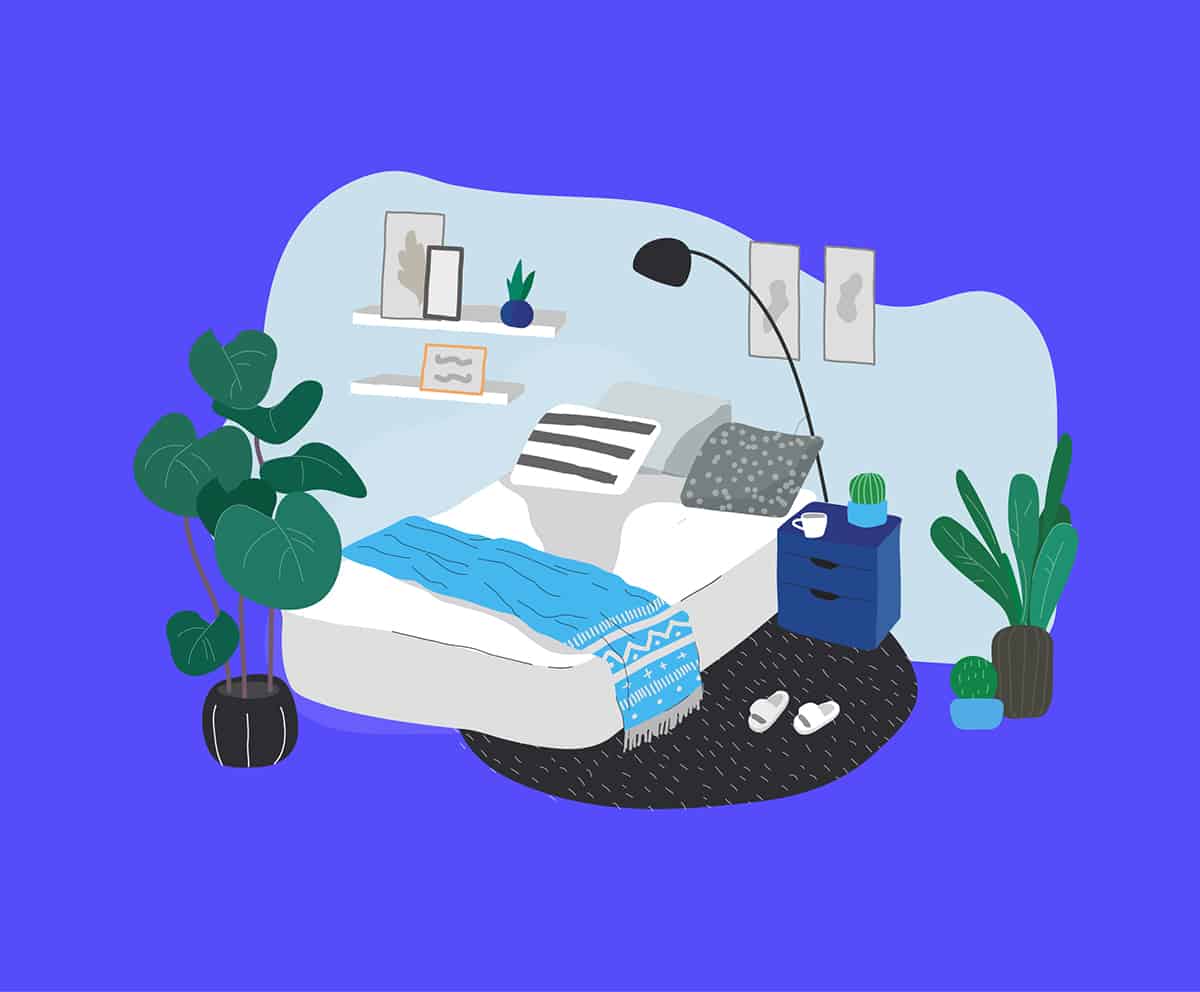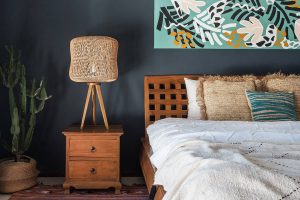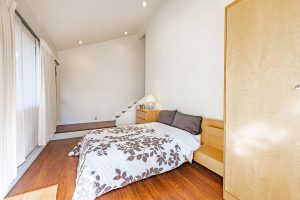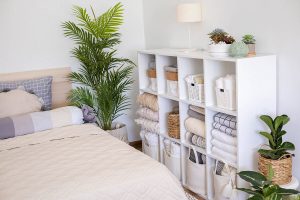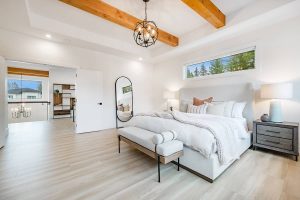Whether you sleep on a simple bed frame with a mattress or one of those luxurious beds shaped as a rollercoaster, you probably enjoy sleeping on a bed. Humans have always enjoyed sleeping on beds. Thousands of years ago, people dug hollow trenches on the ground and lined them with grass to make a bed; today, thankfully, beds are designed with way more parts and made to be as comfortable as possible.
There are several types of modern beds available in stores all over the world today. Most of them vary based on design style, culture, and social class. However, every traditional bed is made up of a couple of parts.
See our amazing diagram that illustrates the parts of a typical bed here.
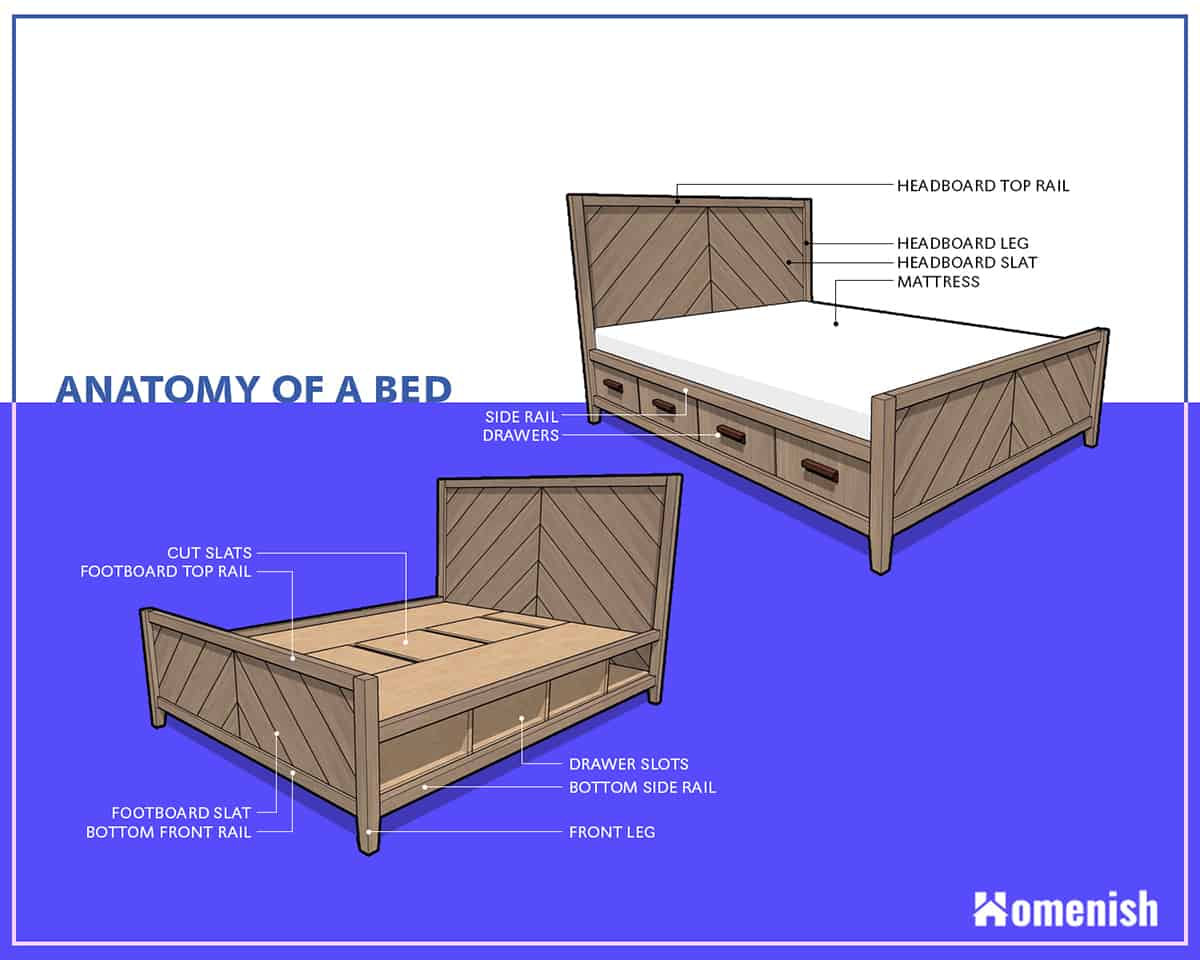
The Headboard
Headboards could come in upholstered or wooden forms. They provide great aesthetics for the bed, but beyond beauty, they were also once really functional.
At first, headboards were used to shield people’s heads from getting too cold at night; however, with the introduction of bedroom heating systems and modern duvets, headboards do not serve this purpose anymore. Headboards also protected people’s heads from hitting the wall during sleep.
Headboards in recent times are there more of a decorative piece of furniture to improve a room’s overall aesthetics. They also protect pillows from slipping off the bed during the night. Stylishly designed headboards make a room a lot more cozy and comfortable and guarantee a comfortable sleep. The headboard is made of several parts, including:
Headboard Slat: These are vertical screens usually set in the back of a bed frame. They typically form the foundation for the headboard.
Headboard Top Rail: these are horizontal pieces that lie across the top of the headboard slat. The headboard slat stands vertically while the headboard top-rail lies horizontally across it. These two pieces make very important components of the headboard.
Headboard Cross Rail: The headboard cross rail lies below the headboard slat and brings stability to the whole headboard setup. It attaches to both the bed and the headboard slat and holds the headboard from its base.
Headboard Leg: As the name implies, headboard legs offer a leg for the headboard slat to stand. It supports the headboard slat on both sides. It is also used to ensure that a headboard stays at its preferred height.
The Side Rails
In an obvious sense, bed rails are those handles installed on both sides of the bed to not only act as a sort of wall but provide security and comfort to babies and adults with reduced mobility. However, other types of side rails exist on a traditional bed frame as follows:
Bed Side Rail: These run horizontally and support the entire length of the bed from the headboard to the footboard. They also provide a cover for things stored under the bed. They’re positioned close to the top of the mattress.
Bottom Side Rail: These are positioned close to the bottom of the bed and lie parallel to the bedside rail, very close to the floor. They also help in providing a cover for items stored beneath the bed. They’re the same as the bedside rail, only positioned lower. They can be made of either wood or metal and run from the headboard to the footboard.
The Footboard
The function of a footboard is to add to the style of your bed, ensure that your bedding stays in place, and improve your room’s overall decor. In the past, they served practical purposes such as protecting sleepers from cold draughts and keeping bed sheets and duvets from sliding off the bed. However, in recent times, they are mainly used for aesthetics.
Footboard Slat: This is the footboard version of the headboard slat, but it’s always shorter than the headboard. It’s a vertical screen joined to the end of the bed frame to support the footboard top rail.
Footboard Top Rail: This is a horizontal panel attached to the top of the footboard slat, largely for decorative purposes, but it also prevents the sheets and duvets from sliding off the bed.
Bottom Front Rail: This is a horizontal panel attached to the bottom of the footboard slat.
Legs
Legs extend down from the sides of the headboard and footboard, separating the bed from the ground. Some beds have legs, while others just sit on the floor without legs.
Cut Slats
These are slats that lie across the bed frame to hold the mattress. The number of slats you have at the base of the bed would determine how stable the mattress is.
They’re usually cut thin and narrow to match the length and width of the bed and used to build an overlapping screen at the base of the bed.
Cleats
You’ll find cleats at the base of the bed. They serve as a stand for the cut slats. Some say the cut slats are a part of the cleat.
Box Spring
Box springs, also called divans in some countries, are usually used to form the base of a bed. They typically consist of a strong wooden frame enclosed in cloth and holding some springs.
They are typically placed over a bed frame which serves as a brace for the box spring. Box springs are usually the same sizes as the mattresses to be used on them. Most beds are typically made up of a box spring, a mattress, and a bed frame, but sometimes people use just a box spring and a mattress without the bed frame.
Different Bed Designs and Parts
If your bed doesn’t seem to have most of the parts listed above, that’s nothing to worry about. Beds have varying sizes and parts depending on their designs. This means that not all beds are made up of the traditional headboard, footboard, and bed frame discussed above. Below are a few bed designs and their parts.
Daybed
You’ll usually find a day bed in people’s guest bedrooms, patios, or their home offices. This is because they are very functional and can be used as a sofa or a bench when the need arises.
It has the appearance of an elegant futon, and one can join two-day beds to make a twin bed. Many times day beds are made of metal and are made of one metal frame, bolts and screws, one footboard, one headboard, two side rails, and crossbars.
Futon
Futons are of Japanese origin, and they’re often used in small rooms. Futons look similar to daybeds and can also be used as couches. More importantly, they can be easily folded up and stored in another part of the house when they’re not in use.
Waterbed
Water beds are popularly used for physical therapy. They’re mattresses filled with water and typically placed on a wooden frame. Sometimes the water in the bed is heated to help soothe aching joints.
Air Bed
When you hear of an airbed, do you picture a bed that floats in the air? Well, that’s not quite right. Airbeds are filled with air and designed to sit on a hardwood frame. Beds that float in the air, on the other hand, are called floating beds.
Magnetic Floating Bed
These beds are designed with magnets to make them float off of the floor. They are expensive and not commonly seen. The reason for this is probably because not a lot of people see the need to levitate off the ground while asleep.
Murphy Bed
Murphy beds are also called wall beds or pull-down beds, mainly because they are designed to be pulled out from the wall when needed and pushed against the wall when not in use.
They have hinges that allow them to be folded up. They are typically used by those who do not have enough space for a traditional bed, such as people living in studio apartments.
Four-Poster Bed
Four-poster beds are typically used in large bedrooms; they have four long posts, each one attached to one corner of the bed.
Low Poster Bed
This looks just like the 4-poster bed, but its posts are a few inches shorter.
Pencil Poster Bed
This is an 18th-century design that looks just like the 4-poster bed, but its posts are much skinnier, hence their name.
Half Poster Bed
This bed has two extremely short posts at each corner at the foot of the bed and two regular-sized tall posts at each corner at the head of the bed.
Round Bed
Most beds are rectangular or square-shaped, but the round bed is designed in a circular shape. They can be as big as regularly sized mattresses, just round. They are great for TV rooms.
Ottoman Bed
Ottoman beds are designed in such a way that they can be raised to reveal huge storage space underneath them. It’s perfect for those who do not have a lot of space in their bedroom because it doubles as a bed and a storage space.
Canopy Bed
Canopy beds look similar to poster beds, as they also have posters fixed at each corner of the bed. However, unlike in poster beds, the posters in canopy beds join to form a frame around the bed. There are two kinds of canopy beds; the traditional canopy bed and the contemporary canopy bed.
Traditional canopy beds have their frames made from thick wood. Contemporary canopy beds, on the other hand, are made of thin frames that can be made from any material of your choice. A thin fabric can be thrown over any canopy bed frame to give the bed a more intimate feel.
